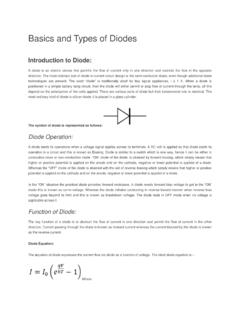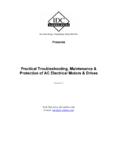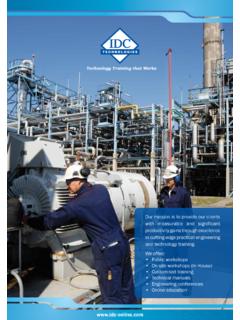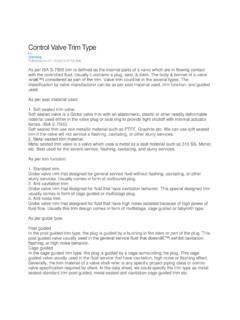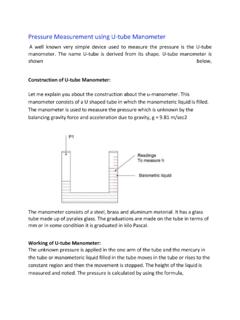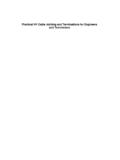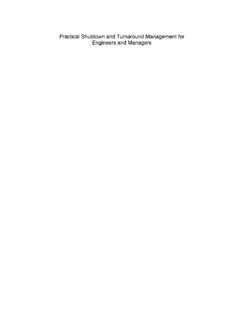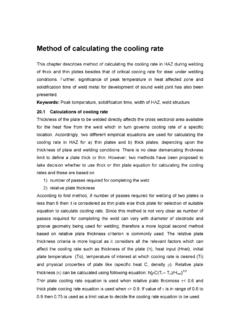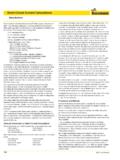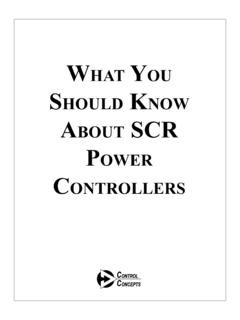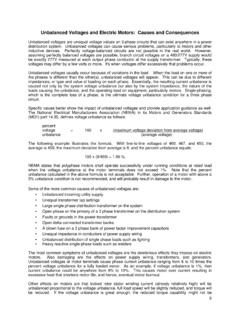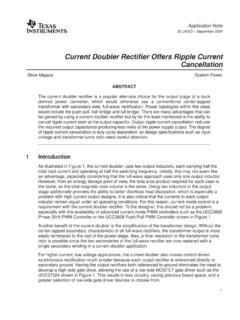Transcription of Principle of operation of CT - IDC-Online
1 current Transformer Principle of operation of CT A current transformer is defined as as an instrument transformer in which the secondary current is substantially proportional to the primary current (under normal conditions of operation ) and differs in phase from it by an angle which is approximately zero for an appropriate direction of the connections. current transformers are usually either measuring or protective types. Some Definitions used for CT: 1) Rated primary current : The value of primary current which appears in the designation of the transformer and on which the performance of the current transformer is based. 2) Rated secondary current : The value of secondary current which appears in the designation of the transformer and on which the performance of the current transformer is based. Typical values of secondary current are 1 A or 5 A. In the case of transformer differential protection, secondary currents of 1/ root 3 A and 5/ root 3 A are also specified.
2 3) Rated burden: The apparent power of the secondary circuit in Volt-amperes expressed at the rated secondary current and at a specific power factor ( for almost all standards) 4) Rated output: The value of the apparent power (in volt-amperes at a specified power (factor) which the current transformer is intended to supply to the secondary circuit at the rated secondary current and with rated burden connected to it. 5) Accuracy class: In the case of metering CT s, accuracy class is typically, , , 1 or 3. This means that the errors have to be within the limits specified in the standards for that particular accuracy class. The metering CT has to be accurate from 5% to 120% of the rated primary current , at 25% and 100% of the rated burden at the specified power factor. In the case of protection CT s, the CT s should pass both the ratio and phase errors at the specified accuracy class, usually 5P or 10P, as well as composite error at the accuracy limit factor of the CT.
3 6) current Ratio Error: The error with a transformer introduces into the measurement of a current and which arises from the fact that actual transformation ratio is not equal to the rated transformer ratio. The current error expressed in percentage is given by the formula: current error in % = (Ka(Is-Ip)) x 100 / Ip Where Ka= rated transformation ratio ,Ip= actual primary current , Is= actual secondary current when Ip is flowing under the conditions of measurement 7) Accuracy limit factor: The value of primary current up to which the CT complies with composite error requirements. This is typically 5, 10 or 15, which means that the composite error of the CT has to be within specified limits at 5, 10 or 15 times the rated primary current . 8) Short time rating: The value of primary current (in kA) that the CT should be able to withstand both thermally and dynamically without damage to the windings, with the secondary circuit being short-circuited.
4 The time specified is usually 1 or 3 seconds. 9) Instrument security factor (factor of security): This typically takes a value of less than 5 or less than 10 though it could be much higher if the ratio is very low. If the factor of security of the CT is 5, it means that the composite error of the metering CT at 5 times the rated primary current is equal to or greater than 10%. This means that heavy currents on the primary are not passed on to the secondary circuit and instruments are therefore protected. In the case of double ratio CT s, FS is applicable for the lowest ratio only. 10) Class PS X CT: In balance systems of protection, CT s with a high degree of similarity in their characteristics is required. These requirements are met by Class PS (X) CT s. Their performance is defined in terms of a knee-point voltage (KPV), the magnetizing current (Imag) at the knee point voltage or 1/2 or 1/4 the knee-point voltage, and the resistance of the CT secondary winding corrected to 75C.
5 Accuracy is defined in terms of the turn s ratio. 11) Knee point voltage: That point on the magnetizing curve where an increase of 10% in the flux density (voltage) causes an increase of 50% in the magnetizing force ( current ). The Knee Point Voltage (Vkp) is defined as the secondary voltage at which an increase of 10% produces an increase in magnetizing current of 50%. It is the secondary voltage above which the CT is near magnetic saturation. 12) Core balance CT (CBCT): The CBCT, also known as a zero sequence CT, is used for earth leakage and earth fault protection. The concept is similar to the RVT. In the CBCT, the three core cable or three single cores of a three phase system pass through the inner diameter of the CT. When the system is fault free, no current flows in the secondary of the CBCT. When there is an earth fault, the residual current (zero phase sequence current ) of the system flows through the secondary of the CBCT and this operates the relay.
6 In order to design the CBCT, the inner diameter of the CT, the relay type, the relay setting and the primary operating current need to be furnished. 13) Phase displacement: The difference in phase between the primary and secondary current vectors, the direction of the vectors being so chosen that the angle is zero for the perfect transformer. The phase displacement is said to be positive when the secondary current vector leads the primary current vector. It is usually express in minutes 14) Highest system voltage: The highest rms line to line voltage which can be sustained under normal operating conditions at any time and at any point on the system. It excludes temporary voltage variations due to fault condition and the sudden disconnection of large loads. 15) Rated insulation level: That combination of voltage values (power frequency and lightning impulse, or where applicable, lightning and switching impulse) which characterizes the insulation of a transformer with regard to its capability to withstand by dielectric stresses.
7 For low voltage transformer the test voltage 4kV, at power-frequency, applied during 1 minute. 16) Rated short-time thermal current (Ith): The rms value of the primary current which the current transformer will withstand for a rated time, with their secondary winding short circuited without suffering harmful effects. 17) Rated dynamic current (Idyn): The peak value of the primary current which a current transformer will withstand, without being damaged electrically for mechanically by the resulting electromagnetic forces, the secondary winding being short-circuited. 18) Rated continuous thermal current (Un) The value of current which can be permitted to flow continuously in the primary winding, the secondary windings being connected to the rated burdens, without the temperature rise exceeding the specified values. 19) Instrument security factor (ISF or Fs): The ratio of rated instrument limits primary current to the rated primary current .
8 The times that the primary current must be higher than the rated value, for the composite error of a measuring current transformer to be equal to or greater than 10%, the secondary burden being equal to the rated burden. The lower this number is, the more protected the connected instrument are against. 20) Sensitivity Sensitivity is defined as the lowest value of primary fault current , within the protected zone, which will cause the relay to operate. To provide fast operation on an in zone fault, the current transformer should have a Knee Point Voltage at least twice the setting voltage of the relay. 21) Field Adjustment of current Transformer Ratio: The ratio of current transformers can be field adjusted to fulfil the needs of the application. Passing more secondary turns or more primary turns through the window will increase or decrease the turns ratio. Actual Turns Ratio = (Name Plate Ration- Secondary Turns Added) / Primary Turns.
9 Types of current transformers (CT s) According to Construction of CT: 1) Bar Type: Bar types are available with higher insulation levels and are usually bolted to the current caring device. Bar type current transformers are insulated for the operating voltage of the system. Bar-type CTs operate on the same Principle of window CTs but have a permanent bar installed as a primary conductor 2) Wound CT s: Capacity: There are designed to measure currents from 1 amp to 100 amps. the most common one is the wound type current transformer. The wound type provides excellent performance under a wide operating range. Typically, the wound type is insulated to only 600 volts. Since the load current passes through primary windings in the CT, screw terminals are provided for the load and secondary conductors. Wound primary CT s are available in ratios from :5 to 100:5. Wound CTs have a primary and secondary winding like a normal transformer.
10 These CTs are rare and are usually used at very low ratios and currents, typically in CT secondary circuits to compensate for low currents, to match different CT ratios in summing applications, or to isolate different CT circuits. Wound CTs have very high burdens, and special attention to the source CT burden should be applied when wound CTs are used. 3) Window: Window CTs are the most common. They are constructed with no primary winding and are installed around the primary conductor. The electric field created by current flowing through the conductor interacts with the CT core to transform the current to the appropriate secondary output. Window CTs can be of solid or split core construction. The primary conductor must be disconnected when installing solid window CTs. However, split core CTs can be installed around the primary conductor without disconnecting the primary conductor Ring Core CT s : Capacity: There are available for measuring currents from 50 to 5000 amps Size: with windows (power conductor opening size) from 1 to 8 diameter.
